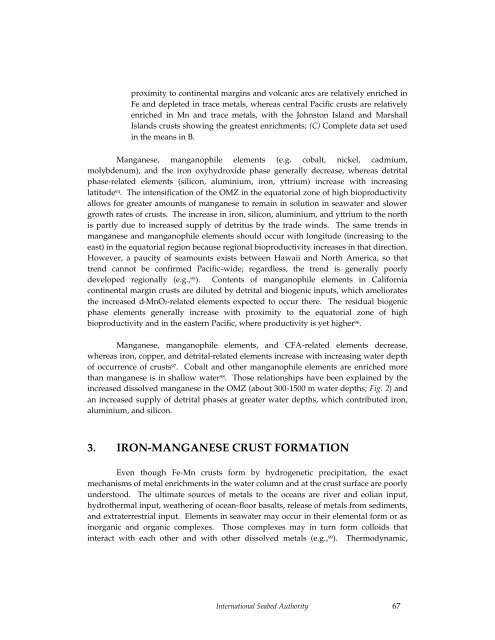Full page fax print - International Seabed Authority
Full page fax print - International Seabed Authority
Full page fax print - International Seabed Authority
You also want an ePaper? Increase the reach of your titles
YUMPU automatically turns print PDFs into web optimized ePapers that Google loves.
proximity to continental margins and volcanic arcs are relatively enriched in<br />
Fe and depleted in trace metals, whereas central Pacific crusts are relatively<br />
enriched in Mn and trace metals, with the Johnston Island and Marshall<br />
Islands crusts showing the greatest enrichments; (C) Complete data set used<br />
in the means in B.<br />
Manganese, manganophile elements (e.g. cobalt, nickel, cadmium,<br />
molybdenum), and the iron oxyhydroxide phase generally decrease, whereas detrital<br />
phase-related elements (silicon, aluminium, iron, yttrium) increase with increasing<br />
latitude 94. The intensification of the OMZ in the equatorial zone of high bioproductivity<br />
allows for greater amounts of manganese to remain in solution in seawater and slower<br />
growth rates of crusts. The increase in iron, silicon, aluminium, and yttrium to the north<br />
is partly due to increased supply of detritus by the trade winds. The same trends in<br />
manganese and manganophile elements should occur with longitude (increasing to the<br />
east) in the equatorial region because regional bioproductivity increases in that direction.<br />
However, a paucity of seamounts exists between Hawaii and North America, so that<br />
trend cannot be confirmed Pacific-wide; regardless, the trend is generally poorly<br />
developed regionally (e.g., 95). Contents of manganophile elements in California<br />
continental margin crusts are diluted by detrital and biogenic inputs, which ameliorates<br />
the increased d-MnO2-related elements expected to occur there. The residual biogenic<br />
phase elements generally increase with proximity to the equatorial zone of high<br />
bioproductivity and in the eastern Pacific, where productivity is yet higher 96.<br />
Manganese, manganophile elements, and CFA-related elements decrease,<br />
whereas iron, copper, and detrital-related elements increase with increasing water depth<br />
of occurrence of crusts 97. Cobalt and other manganophile elements are enriched more<br />
than manganese is in shallow water 98. Those relationships have been explained by the<br />
increased dissolved manganese in the OMZ (about 300-1500 m water depths; Fig. 2) and<br />
an increased supply of detrital phases at greater water depths, which contributed iron,<br />
aluminium, and silicon.<br />
3. IRON-MANGANESE CRUST FORMATION<br />
Even though Fe-Mn crusts form by hydrogenetic precipitation, the exact<br />
mechanisms of metal enrichments in the water column and at the crust surface are poorly<br />
understood. The ultimate sources of metals to the oceans are river and eolian input,<br />
hydrothermal input, weathering of ocean-floor basalts, release of metals from sediments,<br />
and extraterrestrial input. Elements in seawater may occur in their elemental form or as<br />
inorganic and organic complexes. Those complexes may in turn form colloids that<br />
interact with each other and with other dissolved metals (e.g., 99). Thermodynamic,<br />
<strong>International</strong> <strong>Seabed</strong> <strong>Authority</strong> 67

















